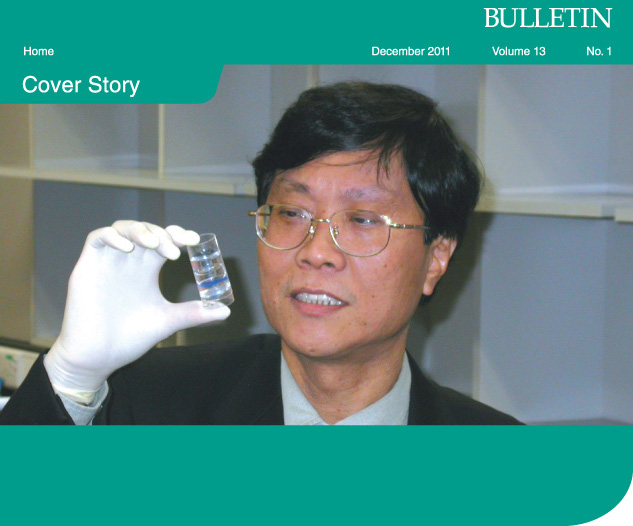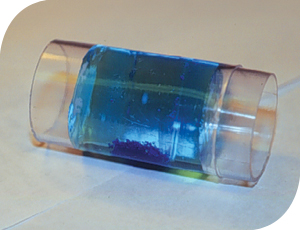
|
|
For decades scientists have turned to live mussels to monitor levels of heavy metals in seawater. The shellfish, however, are not reliable indicators of changing pollution levels. But an artificial mussel, developed by Professor Rudolf Wu, Director of the Centre for Environmental Research and Innovative Technology, at HKU, is proving more than capable of fulfilling the task. The chemical sampling device, or artificial mussel, is a Perspex tube that houses a metal binder that can be lowered into marine waters to provide a time-integrated estimate on metal concentration. It has proven so successful that Professor Wu is now working with partners worldwide to monitor marine pollution. "This is global," says Professor Wu. "We test the artificial mussel in the laboratory and in the field and we are collaborating with a number of countries including South Africa, Australia, USA, Brazil, Iceland, Portugal, Morocco, Mainland China and England. We send them the device and they put it side by side with the actual mussels." Unreliable readings There are several ways of testing water for pollutants but many of them give unreliable readings. "We all agree that heavy metals are toxic and that we need to monitor them to see if the water in Victoria Harbour, for example, is getting worse or better," explains Professor Wu. "But the problem is that when you measure pollutants in water the levels never stay the same, because the water is affected by so many different factors." "You can actually receive a different answer every time you test it. So you have to take a lot of samples, you may have to take samples five times a week which is not practical and very expensive." "People have tried using sediment samples instead, but sand does not retain metals so well. So there's difficulty in comparing one site with another, say comparing Victoria Harbour with Lantau Island, because the sediment is different." "This is why in the 1970s the United States introduced the Global Mussel Watch Programme. Mussels can concentrate the heavy metals in water by a million times. So you can use mussels to test the concentration. But they are sensitive to temperature, salinity, and pollution levels. For example, if you put the mussels in Victoria Harbour they will die from or be affected by the pollution." "The results also depend on what food the mussels eat and what part of their cycle they are in, so the whole process is extremely messy and subject to unreliable results." A standard tool And, as if this was not enough, mussel varieties differ from area to area. New Zealand mussels, for example, are very different to Hong Kong mussels, which are very different again to California mussels, and they all take up heavy metals at a different rate. "In the US programme, which they have run for 30 years, they have to use 25 different species of mussel, but have found it difficult to make comparison" says Professor Wu. |
But the beauty of the artificial mussel is that it is a standard tool that can monitor heavy metals in almost all aquatic environments including rivers, estuaries, waste water, recycled water, ground water and seawater. It can even be used in areas where live mussels are not available. "The artificial mussels are not affected by temperature, they don't grow and they don't feed. Furthermore, this is the first time we have been able to provide data for accurate world-wide comparison. We have run workshop on how to use this device for 11 countries in the Pacific region. The International Atomic Energy Agency commissioned us to run a workshop in Vienna last year to show people from eight countries how this system works." |  Artificial mussel. |
|
Testing China's waters "China supplies 50 per cent of the world's aquaculture products. But in 2007 it received 315 entry refusals from the US coastguard for these products, because they were not up to standard." "What we want to do is help China test their waters. Water pollution in China is a big issue. The drinking water of over 100 million people is contaminated with animal waste, there are estimated to be 60,000 premature deaths every year, most of the shellfish in coastal areas contains unacceptable levels of toxic chemicals and pathogens. There are numerous outbreaks of epidemic disease, high chemical rates, high levels of liver and stomach cancer, all related to water consumption. "All this affects China's GDP, so it causes a big economic loss. The government takes it very seriously so we are trying to look at the system and trying to identify the source and the distribution – where do these pollutants come from, where do they go? In some case, when a pollutant enters the environment it can change from something less toxic into something very toxic." To gain answers Professor Wu is using the small Medaka fish to test for endocrine-disrupting chemicals, toxic chemicals and carcinogens in the environment. "What we want to do is some forecasting before the damage occurs. Then I can tell you whether or not a particular fish is suitable for eating. You need a very quick, reliable method of detecting the toxins or pollutant level in seafood. At the moment the technology is not there, so that's why we are trying to look at whether gene, protein and metabolite changes in the fish, can be related to pollutants. Based on these fundamental studies, we can develop a biomarker. What we hope to achieve is high impact research that makes a real difference in environmental management in the years to come."
|
| Back | Next | |